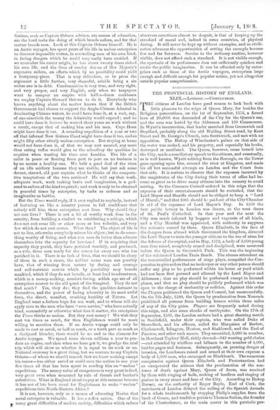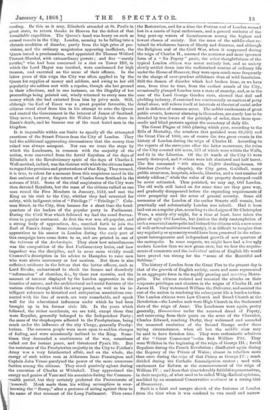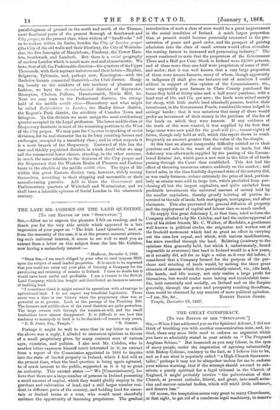T HE citizens of London have good reason to look back
with little pleasure to the reign of Queen Mary, for besides the Religious persecutions, on the 1st of September, 1553, a forced loan of 20,000/. was demanded of the City for the Queen's use, and the sum was levied by the Aldermen and 120 Commoners. In Wyatt's insurrection, that leader marched from Greenwich and Deptford, probably along the old Watling Street road, by Kent Street and St. George's Church, into Southwark, and met with no opposition. The Bishop of Winchester's palace on that side of the water was sacked, and his property, and especially his books, destroyed or mutilated. The Queen, however, came herself into the City, made a conciliatory speech to the citizens, and eventually, as is well known, Wyatt retiring from the Borough, on the Tower guns opening upon him, crossed the river at Kingston, and made his all but successful attempt on London and 'the Court from that side. It is curious to observe that the expenses incurred by the magistrates of the City during their terms of office had be- come so great as to drive many citizens into the country to avoid serving. So the Common Council ordered in this reign that the expenses of their entertainments should be curtailed, that the Lord Mayor and Sheriffs should not be obliged to keep a " Lord of Misrule," and that 100/. should be paid out of the City Chamber in aid of the expenses of Lord Mayor's Day. Iu 1569 the first public lottery in London was drawn, at the west doors of St. Paul's Cathedral. In that year and the next the City was much infested by beggars and vagrants of all kinds, and a City Marshal was appointed, with authority to suppress the nuisance caused by them. Queen Elizabeth, in the face of the dangers from abroad which threatened the kingdom, directed the Lord Mayor to train the younger citizens to the use of arms for the defence of the capital, and in May, 1572, a body of 3,000 young men thus raised, completely armed and disciplined, were mustered before the Queen iu Greenwich Park. This was the beginning of the celebrated London Train Bands. The abuses attendant on the uncontrolled performance of stage plays, compelled the Cor- poration to give orders that no innkeeper or any other person should suffer any play to be performed within his house or yard which had not been first perused and allowed by the Lord Mayor and Aldermen ; that no play should be performed except in licensed places, and that no play should be publicly performed which was open to the charge of unchastity or sedition. Against this order the Players petitioned the Queen and Council, but unsuccessfully. On the 7th July, 1580, the Queen by proclamation from Nonsuch prohibited all persons from building houses within three miles of any of the City gates. Plagues are frequently noted during this reign, and also some shocks of earthquake. On the 17th of September, 1583, the London archers had a great shooting match in Smithfield, under their captain, who was called Duke of Shoreditch, and his officers, called the Marquises of Barlow, Clerkenwell, Islington, Hoxton, and Shaklewell, and the Earl of Pancras, and other such names. They assembled, 3,000 in number, in Merchant Taylors' Hall, richly dressed-942 wearing gold chains —and attended by whiffiers and billmen to the number of 4,000, besides pages and footmen. Subsequently, on pressing danger of invasion, the Londoners raised and armed at their own expense a body of 5,000 men, who encamped on Blackheath. The numerous conspiracies against Queen Elizabeth and Protestantism had so exasperated the citizens that the proclamation of the sen- tence of death against Mary, Queen of Scots, was received by them with ringing of bells, making of bonfires and singing of palms in every street and lane of the City. According to Bishop Burnet, on the authority of Roger Boyle, Earl of Cork, the merchants of London delayed the sailing of the Spanish Armada for a whole twelvemonth by stopping Philip's supplies from the bank of Genoa, and tradition points to Thomas Sutton, the founder of the Charterhouse, as the main mover in this patriotic pro- ceeding. Be this as it may, Elizabeth attended at St. Paul's in great state, to return thanks to Heaven for the defeat of that formidable expedition. The Queen's hand was heavy on such as caused tumults in the City. London, seeming to be falling into a chronic condition of disorder, partly from the high price of pro- visions, and the ordinary magistrates appearing inefficient, the Queen issued a proclamation, and appointed Sir Thomas Wilford Provost-Marshal, with extraordinary powers ; and five " unruly youths," who had been concerned in a riot on Tower Hill, in which the Lord Mayor was insulted, were condemned for high treason, and executed on the scene of their offence. In the latter years of this reign the City was often applied to by the Queen for supplies of money and soldiers, and owing to her old popularity she seldom met with a repulse, though she lost ground in their affections, and in one instance, on the illegality of her proceedings being pointed out, wisely returned to every man the money which she had extorted from him by privy seals. Still, although the Earl of Essex was a great popular favourite, the citizens etood aloof froni him in his attempt to seize the Queen and control the Government in the interest of James of Scotland. They never, however, forgave Sir Walter Raleigh his share in Essex's death, and he became one of the most hated men in the kingdom.
It is impossible within our limits to specify all the attempted exactions of the Stuart Princes from the City of London. They bad the additional aggravating circumstance that the money thus raised was always misspent. Nor can we trace the steps by which the Londoners, in common with the majority of the nation, were converted from the fervid. Royalism of the days of Elizabeth to the Revolutionary spirit of the days of Charles I. Well merited, indeed, was the distrust with which the citizens learnt to regard the promises and protestations of that King. They seemed, it is true, to relent for a moment from this suspicious mood in the first outburst of joy at the return of Charles from Scotland in the autumn of 1641. Some of the chief magistrates of the City were then devoted Royalists, but the mass of the citizens rallied as one man round the Five Members in January, 1612, and met the King on his visit to the City, whither they had retreated for safety, with indignant cries of " Privilege !" " Privilege !" Cole- man Street, in the City, then became for a short time the head- quarters of the leaders of tho popular party in Parliament. During the Civil War which followed we find the usual fluctua- tions in popular sentiment. At first the 'der was all-popular, and a strong body of apprentices, &c., marched forth to join the Earl of Essex's Army. Some curious letters from one of these apprentices to his master in London during the early part of this campaign have come down to us, and are printed in one of the volumes of the Archmologia. They show how miscellaneous was the composition of the first Parliamentary levies, and how imperfect was the discipline, and in some cases vividly recall Cromwell's description in his advice to Hampden to raise men who were above mercenary or low motives. But there is also sufficient evidence in the letters that the better officers, such as Lord Brooke, endeavoured to check the licence and disorderly " reformation " of churches, &c., by these raw recruits, and the amount of interest displayed by the London apprentice in the beauties of nature, and the architectural and social features cf the various cities through which the army passed, as well as his in- telligent reference to historical and antiquarian associations con- nected with his line of march, are very remarkable, and speak well for the educational influences under which he had been brought up in his former civic life. In the years which followed, the richer merchants, we are told, except those that were Royalist, generally belonged to the Independent Party ; the mass of the shopkeepers adhered to the Presbyterians, being much under the influence of the city Clergy, generally Presby- terians. The common people were more open to sudden changes of feeling, and were occasionally inclined to the King. Some- times they demanded a continuance of the war, sometimes called out for instant peace, and threatened Pym's life. But the resistance of the Presbyterian majority in the City to Fairfax's Army was a very fainthearted affair, and on the whole, the energy of such active men as Alderman Isaac Pennington and Captain John Venue paralyzed the power of the more numerous faction among the citizens. They stood passively aghast during the execution of Charles at Whitehall. They appreciated the energy and genius of Vane and his associates during the Common- -vealth period, but they certainly preferred the Protectorate of Cromwell. Monk made them his willing accomplices in over- hrowing the " Rump," after a pretence of acting against them in he name of that remnant of the Long Parliament. Then came
the Restoration, and for a time the Puritan zeal of London seeme 1 lost in a mania of loyal enthusiasm, and a general outburst of the long pent-up waters of licentiousness among the highest and lowest classes of society. But the mass of the middle-class re- tained its wholesome leaven of liberty and decorum, and although the Religious zeal of the Civil War, when it reappeared during the reign of Charles IL, assumed the narrower and more ignorant form of a " No Popery " panic, the sober thoughtfulness of the typical London citizen was never entirely lost, and as society slowly settled down into the undisturbed routine of ordinary life under the House of Hanover, they were open much more frequently to the charge of over-prudent selfishness than of wild fanaticism. Still the demon of disorder which had broken loose, as we have seen, from time to time, from the earliest annals of the City, occasionally plunged London into a state of anarchy, and, as in the case of the Lord George Gordon riots, showed that dull and plodding industry, if exercised too continuously on matters of petty detail alone, will relieve itself at intervals at the cost of social order and in defiance of common sense. The nobler excitements of great public events, however alarming in themselves, are surely less to be dreaded by true lovers of the principle of order, than these spas- modic and blind protests against the monotony of daily life.
The Great Plague of 1665 (during which year, according to the Bills of Mortality, the nnmbers that perished were 68,590) and the Great Fire of 1666, are of course the two great events in the history of London during the reign of Charles II. According to the reports of the surveyors after the latter occurrence, the ruins of the City covered 436 acres, 373 of which were within the Walls, and 61 in the Liberties. Of the 26 wards of the City 15 were nearly destroyed, and 8 others were left shattered and half burnt. The fire consumed "400 streets, 13,200 dwelling-houses, 89 churches (besides 4 chapels), the City gates, Guildhall, many public structures, hospitals, schools, libraries, and a vast number of stately edifices ;" while the value of the property destroyed could be never estimated. Thus perished, we may say, Old London. The old walls still lasted on for some time ere they gave way, and gradually disappeared before the expanding requirements of civic prosperity and the sense of general security. Some old mementos of the London of the earlier Stuarts still remain, but practically and substantially London was rebuilt. Had it been laid out on a regular plan, according to the designs of Sir Christopher Wren, a stately city might, for a time at least, have taken the place of ugly Old London, but (unless the daily contemplation of such a renovated metropolis had imbued the citizens with a new sense of well-ordered architectural beauty), it is difficult to imagine that any regularity or symmetrywould have been preserved in the subse- quent heterogeneous and independent growth of new quarters of the metropolis. In some respects, we might have had a less ugly modern London than we now groan over, but we fear the require- ments of commerce and the individual action of English life would have proved too strong for the " sense of the Beautiful and Sublime."
The history of London from the Great Fire to the present day is that of the growth of English society, more and more represented in an aggregate form in the rapidly growing and accreting Metro- polis. The citizens resisted and resented the attacks on their corporate privileges and charters in the reigns of Charles H. and James II. They welcomed William the Deliverer, and assisted the rest of the nation in rendering his subsequent life a burden to him. The London citizens were Low Church and Broad Church at the Revolution—the London mob were High Church in the Sacheverel riots of the reign of Anne. The Londoners were again, pretty generally, Hanoverian under the renewed dread of Popery, and recovering from their panic on the news of the Chevalier, Charles Edward, reaching Derby, they welcomed and seconded the unmoved resolution of the Second George under these trying circumstances, when all but the middle class may be said to have forsaken him. They were enthusiastic admirers of the " Great Commoner "—the first William Pitt. They were Wilkites in the beginning of the reign of George III. ; fervid Royalists during the French Revolution ; disaffected again during the Regency of the Prince of Wales ; almost in rebellion more than once during the reign of that Prince as George IV. ; much divided during the Catholic Emancipation contest ; mad with excitement for Reform at the commencement of the reign of William IV. ; and from that time tolerably faithful representatives, in their majority, of what used to be called Whig-Radical opinions, modified by an occasional Conservative sentiment or a strong hint of Democracy.
Such is a faint and meagre sketch of the fortunes of London from the time when it was confined to two small and narrow
parallelograms of ground on the north and south of the Thames, mere fractional parts of the present Borough of Southwark and City proper, to the present time, when writers of " handbooks " tell us to reckon within its limits, besides the City of London proper (the City of the old walls and their liberties), the City of Westmin- ster, the five boroughs of Marylebone, Finsbury, the Tower Ham- lets, Southwark, and Lambeth. But there is a social geography of modern London which is much more real and characteristic. We have, first of all, the Fashionable districts—the quarters of the Upper Thousands, with their aspirant imitators and their helots—Mayfair, Belgravia, Tyburnia, and, perhaps now, Kensington—with the Bachelor haunts connected therewith—the Club district. Hang- ing loosely on the outskirts of this territory of pleasure and fashion, we have the de-suburbanized districts of Bayswater, Brompton, Chelsea, Fulham, Hammersmith, Maida Hill, &c. Next we may turn to the Professional districts, the strong- hold of the middle middle class—Bloomsbury and what might be called Bedfordshire in London, the Harley Street district, the Regent's Park district, the outskirts of Camden Town and Islington. To this division we must assign the semi-residentiary quarter occupied by the Legal profession. The lower middle class or Shopocracy dominate in most of the remaining portions to the West of the City proper. We may pass the City over in speaking of social divisions, for its real character lies in its busy counting-houses and exchanges, occupied by a transitory class ; and in other respects it is a mere branch of the Shopocracy. Eastward of this lies the vast and thickly populated districts in which dwell what we may call the commercial lower classes, standing, in the other extreme, in much the same relation to the denizens of the City proper and the Shopocracy that the Western Realm of Pleasure and Fashion bears to the citadels of the middle middle class. The types of life within this great Eastern district vary, however, widely among themselves, according to their shipping and mercantile or their manufacturing pursuits. Add to these the Government and Parliamentary quarters of Whitehall and Westminster, and we shall have a tolerable epitome of Social London in the nineteenth century.










































 Previous page
Previous page